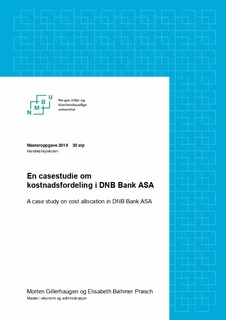| dc.contributor.advisor | Kristiansen, Glenn Roger | |
| dc.contributor.author | Gillerhaugen, Morten | |
| dc.contributor.author | Prøsch, Elisabeth Bøhmer | |
| dc.coverage.spatial | Norway | nb_NO |
| dc.date.accessioned | 2019-08-12T08:20:53Z | |
| dc.date.available | 2019-08-12T08:20:53Z | |
| dc.date.issued | 2019 | |
| dc.identifier.uri | http://hdl.handle.net/11250/2607831 | |
| dc.description.abstract | Denne avhandlingen tar for seg problematikken rundt kostnadsfordeling i DNB Bank ASA. Formålet med avhandlingen er å undersøke hvordan DNB, med sin kompliserte forretningsstruktur, kan fordele interne kostnader knyttet til tjenesteproduksjon.
Det finnes relativt lite teori om fordeling av interne kostnader, og generelt er det meste av teorigrunnlag knyttet til kostnader basert på industri og vareproduksjon. Vi ønsker derfor at denne avhandlingen kan være et bidrag til hvordan kostnader knyttet til felles tjenester fordeles.
Avhandlingen er en teoridrevet casestudie som tar for seg fem reelle caser og problemstillinger i selskapet i dag. Den bygger på både kvalitative og kvantitative data. Avhandlingen benytter seg av kvantitativ kostnadsdata fra DNB for å kunne sammenligne de ulike modellene. Den kvalitative dataen er innhentet fra jevnlig dialog med ansatte som jobber med kostnadsfordeling i DNB.
Dataen som er benyttet i avhandlingen omhandler kostnader knyttet til de fem valgte casene. Gjennom analyser ser vi på ulikhetene mellom gjensidig og direkte fordeling opp mot dagens fordeling, samt en egenkonstruert modell kalt inntektsbasert gjensidig fordeling. Denne fordelingsmodellen baserer seg på tanken om en engangsavgift for faste- og utviklingskostnader. Hvordan de ulike fordelingsmetodene påvirker selskapets måltall blir også undersøkt.
Funn fra analysen og diskusjonen viser at det er vanskelig å konkludere med en anbefalt fordelingsmetode for DNB, fordi det ligger flere drivere bak det å fordele kostnader. I et selskap med en komplisert forretningsstruktur som også opererer i utlandet, må internasjonalt regelverk følges. En direkte fordeling ville ha vært anbefalt hvis det var et helnorsk selskap, men vil være vanskelig å bruke for datterselskaper og filialer i utlandet. For å forenkle fordelingsprosessen vil vi anbefale at det sees på mer enn bare fordelingen av kostnadene, også budsjettpraksis, men ut fra dagens situasjon kan en gjensidig fordeling egne seg for DNB Bank ASA. | nb_NO |
| dc.description.abstract | This thesis addresses the issue of cost allocation in DNB Bank ASA. The purpose of this thesis is to review how DNB, with its complicated business structure, can allocate internal cost connected to services.
There exists little theory on allocation of internal costs, and most of the existing theory is based on industry and manufacturing. Therefore, we wish to contribute to theory on allocation of costs related to joint services through the work done in this thesis.
The thesis is a theory-driven case study that addresses five real cases and issues that exists in the company today. It is based on both qualitative and quantitative data. The thesis uses quantitative cost data from DNB to be able to compare the various models on cost allocation. The qualitative data comes from regular dialogue with employees working with cost allocation in DNB.
The data used in this thesis consists on cost related to our five cases. Through analysis, we look at differences between direct and reciprocal distribution compared to the present allocation model on the given cases. We also examine a self-made allocation model called income-based reciprocal allocation. This allocation model is based on the idea of a one-time fee for fixed – and development costs. The thesis also calculates on how the different model's effect the company’s measurements.
Findings from the analysis and our discussion show that it is difficult to conclude on one recommended allocation method for DNB, because there are several drivers behind cost allocation. In addition to a complicated business structure, DNB Bank ASA also operates internationally. Consequently, international regulations must be followed. A direct allocation model is recommended if the company solely abides Norwegian regulations. However, taking international branches into consideration complicates this model. In order so simplify the allocation process, we recommend broadening the scope and in addition to reviewing allocation of cost including budgeting practices. Based on the current situation, a reciprocal distribution may be appropriate for DNB Bank ASA. | nb_NO |
| dc.language.iso | nob | nb_NO |
| dc.publisher | Norwegian University of Life Sciences, Ås | nb_NO |
| dc.rights | Attribution-NonCommercial-NoDerivatives 4.0 Internasjonal | * |
| dc.rights.uri | http://creativecommons.org/licenses/by-nc-nd/4.0/deed.no | * |
| dc.title | En casestudie om kostnadsfordeling i DNB Bank ASA | nb_NO |
| dc.title.alternative | A case study on case allocation in DNB Bank ASA | nb_NO |
| dc.type | Master thesis | nb_NO |
| dc.subject.nsi | VDP::Samfunnsvitenskap: 200::Økonomi: 210::Bedriftsøkonomi: 213 | nb_NO |
| dc.description.localcode | M-ØA | nb_NO |

